The world’s largest aircraft carrier, USS Gerald R. Ford (CVN 78), has entered the Mediterranean Sea, transiting the Strait of Gibraltar on 19 July 2025.
Accompanying the Ford were Arleigh Burke-class destroyers USS Winston S. Churchill (DDG 81) and USS Bainbridge (DDG 96), the Spanish Navy frigate Canarias (F86), and the fast combat support ship USNS Supply (T-AOE 6). The carrier strike group forms part of Carrier Strike Group Twelve, now operating under U.S. 6th Fleet in support of U.S., Allied, and partner interests across the European theatre.
“Our ship and crew has assumed the watch in U.S. 6th Fleet. Gerald R. Ford’s mission remains clear: maintain freedom of navigation in international waters for all nations,” said Captain David Skarosi, commanding officer of the Ford. “Our Sailors are excited to execute this mission and operate side-by-side with our Allies and partners throughout the region.”
Spanish Navy commanding officer of Canarias, Commander J. David Garcia, highlighted the importance of the transit: “This operational activity in the Strait of Gibraltar shows the solid commitment of Spain as a strong Ally in a key access point to the Mediterranean Sea.” He added that the U.S.-Spanish naval relationship, anchored at Rota Naval Base, is built on a “firm friendship, which makes us stronger together.”
The U.S. Navy described the transit as a demonstration of “a credible and capable naval presence” and a visible commitment to regional security and NATO cohesion. The Ford’s deployment follows earlier activity in the U.S. 2nd and 4th Fleet areas and continues the United States’ strategic push in the Euro-Atlantic under its maritime security commitments.
The USS Gerald R. Ford
She is the lead ship of the U.S. Navy’s newest class of nuclear-powered aircraft carriers, marking the first significant redesign of the fleet carrier since the Nimitz-class. It displaces over 100,000 tons and measures approximately 1,106 feet in length.
Powered by two A1B nuclear reactors, the ship generates significantly more electrical power than its predecessors, allowing for the integration of future technologies such as directed energy weapons. The new electromagnetic aircraft launch system (EMALS) replaces steam catapults, offering smoother launches, less stress on aircraft, and reduced maintenance.
Designed for greater efficiency, the Gerald R. Ford supports a higher sortie generation rate while requiring a smaller crew. It features the Advanced Arresting Gear (AAG) for more reliable aircraft recovery and redesigned weapons elevators that move ordnance more quickly between the magazines and flight deck. The ship is built to accommodate more than 75 aircraft, including the F/A-18E/F Super Hornet, EA-18G Growler, E-2D Advanced Hawkeye, MH-60R/S helicopters, and the F-35C Joint Strike Fighter.
Survivability and adaptability are central to the ship’s design. The Ford incorporates 23 new or significantly upgraded systems, including the dual-band radar (DBR), which combines S-band and X-band arrays for enhanced tracking and engagement capabilities.


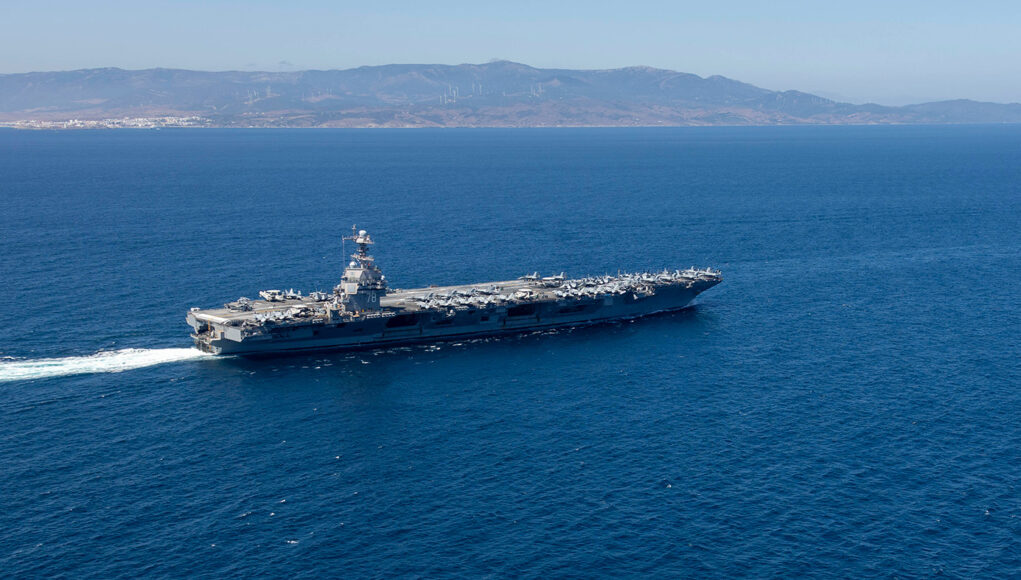
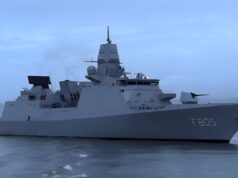
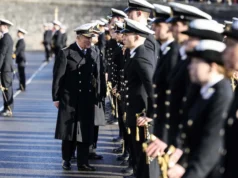
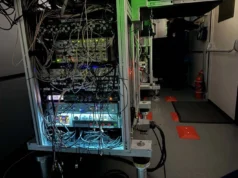
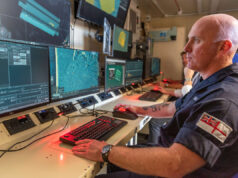
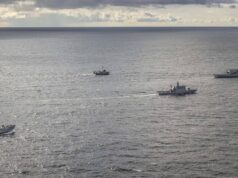
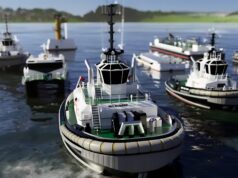
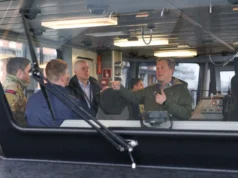
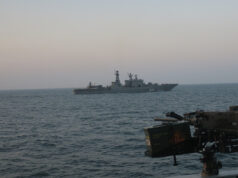
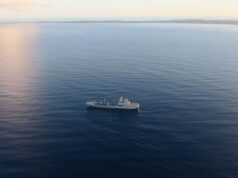
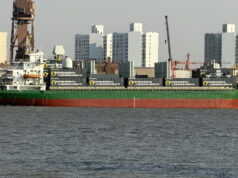

This whole “Most powerful” label seems to be often used when describing phisical size, it would be good to see actual data to back up the label.
An Ohio class boat might argue the toss.
Not to mention our very own River B2’s.
Shhh… You’ve already been told not to mention our very own River B2’s! That’s where the billions really go.
Purely in terms of the ordinance they can deliver to a target there is nothing else like it. Plus… they have Grumman E-2 Hawkeyes, and I’m guessing the aircraft can also carry nuclear bombs, and these carriers move about with submarines and destroyers. The world is changing though and they are probably vulnerable to long range anti-ship missiles, just like any other ship.
Ordnance. Ordinance is very different!
I take your point about nuke subs though. And the awesome power of the River Class. Lol. Although they seem to be getting a fair amount of use these days, and their relatively unthreatening nature has political benefits as well.
Infact the most powerful aircraft carrier on the planet is the French one.. because they can launch a strike of 20-40 strategic level cruise missiles from it .. Charles de Gaulle is the only carrier that can kill a country.
J,
Potentially, a quite interesting issue. Although neither F/A-18F or F-35C are currently certified for the nuclear mission (B61-12), that may not remain the case for the indefinite future. Once New START implodes (😉) after 5 Feb 26, predict many interesting developments amongst all the acknowledged principals.
Could we just have a lot of rivers & astutes and nothing else? Good cop bad cop navy.
Simon, you are clearly joking. River class PBs and Astutes do not deliver air power.
😀
I wonder where they are with aircraft sorry rates. Last time it was reported on the were still having to shut down air opps on one day in five for work on the catapult.
If the Ford could significantly exceed the Nimitz sortie generation rate in the real world then I would expect the USN to be shouting the fact from the rooftops. They don’t appear to be.
THe predicted sortie rate was questioned when it came into service.
J,
“…aircraft sorry rates.” Amusing critique of F-35C current capability, whether an intended pun or not. 🤔😉👍
Though a very impressive ship don’t believe all the hype, it was commissioned Jul. ’17 by Trump during his first term, but the build was not completed until the last weapons elevator was installed and made operational in Dec. ’21 ! Testing is still ongoing with deployments, only the second in June this year, has more crew than bunks, as far as know the higher sortie generation rate has never been demonstrated, the radar was the only set installed on a US ship as the follow-on Kennedy will have a completely different radar etc., etc.
To be fair, the USS Gerald R. Ford is the most complex warship ever built. As the first ship in a new class of supercarriers, its complexity is magnified by the challenges of being a technological trailblazer—testing and integrating numerous advanced systems at scale for the first time, which inevitably leads to delays, cost overruns, and performance issues.
Quite Right.
Its one of the slowest US Navy ships ever built by taking over sixteen years, unable to fly the F-35 as it was considered too expensive to fit the necessary kit due to overspend in build, now the follow-on Kennedy is delayed two years due to some of the same tech wizz kit still causing problems, issues with the Advanced Arresting Gear and Advanced Weapons Elevator systems, Ford a classic example concurrency, where tech gear gear fitted before proven e.g. the the Electromagnetic Aircraft Launch System (EMALS) has experienced major reliability issues, falling well below the specified requirement of 4,166 cycles before failure as met by the old steam catapult.
I watched a very good lecture by the USN Programme Manager for the Ford Class on YouTube from maybe a decade back, and he said his biggest mistake was overspecifiying the radar and his biggest worry was the arresting gear.
I see this Carrier Group has a Spanish escort frigate. Can’t the Americans supply all their own escorts and not have to beg other nations. [That is a joke, dear friends!]
Also I like th ename of the supply ship! Very original.
“I will see your USS Supply and raise you with HMS Boaty McBoatface!”
Seriously, though, I think this USS Supply is the 4th or 5th ship of that name in the USN. Wiki says 4 but I think there was another. And I just found out about USS Supply’s famous camel supply journey! It brought 21 camels from Smyrna in the Ottoman Empire to Texas. Now that is a story worth telling!
That’s USNS Supply. Calling it USN would be like calling RFA Stirling Castle HMS, and we’d never do that!
I see what you did there Jon 😂
It’s always best to point out any intended humour on here, mostly it goes unoticed/unrecognised.
(not being funny at all).🤡
Too much new technology. They should have taken an iterative approach. The weapons lifts, work on land, don’t work at sea. The AAG, again faulty. These delays create longer tours for everyone else. It still doesn’t fly the F35 and at 15 years to build it’s way too long. First in class, ok lots of issues but the Kennedy has a whole bunch of problems with delays extending into years as well. They haven’t a hope if keeping up with China. The Constellation programme is deep in doggy doo do as well. Their destroyers are getting seriously old, circa 28 will be over 30 years old in the next 5 years. No the United States is no longer a super power. A large regional power, which is deeply in debt with a declining industrial base and fast ageing navy.
“No the United States is no longer a super power. A large regional power, which is deeply in debt with a declining industrial base and fast ageing navy.”
This is an asinine thing to say and screams personal hatred for the US far far more than any base in reality
You are defo. still a superpoower, but the rest is true and also for the UK and France. This is why the West has to wake up.
In the UK our current govt. has started to do this while the USA govt. is planning major cuts.
Only welfare and pension reform can free the cash needed and at the moment Reform is threatening that; I suspect on instructions from Moscow.
Agree, the US is still a superpower but a declining one for the reasons mentioned by Dragonwight. I would add declining education standards and cult addiction (poitical and religious) by much of the electorate.
No, the UK does not have the capacity to produce a lot of Astute subs! The RN also needs vessels that are a step-up from River OPV’s, similar to LCS Freedom Class.
Just not a copy of that class with the laundry list of issues and some being retired already.
Respect to the crews of our rivers ,some may say that the hard work during Ww2 was done by destroyers, frigates,sloops and corvette ,lots of small ships instead of a few massive ships but at least at the time they had lots of weapons.
I was lucky enough to be in Halifax the other day and spent a couple hours aboard one of the last remaining Flower Class corvettes, HMCS Sackville. What a great time! I can not imagine the conditions aboard in the North Atlantic!
https://en.wikipedia.org/wiki/HMCS_Sackville
The closest we can get is “the cruel sea”… The little ships do big work thanks for your reply 👍
Did the headline change from ” most powerful ship” to “most powerful carrier” recently? Because I could have sworn it was “most powerful ship” to begin with… LOL!